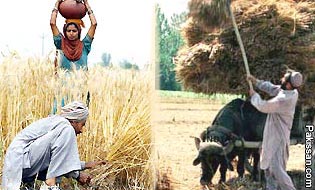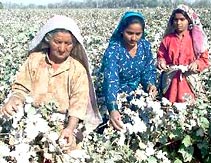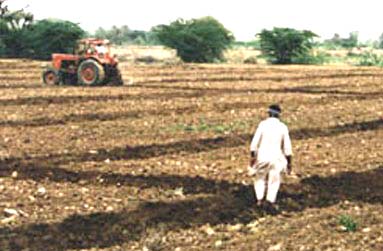|
Challenges and constraints facing
small farmers
By Dr M. Siddique Javed,
Azhar Abbas & Dr A.D. Sheikh
IN developing countries, agriculture continues to be the
main source of employment, livelihood and income for between
50-90 per cent of the population. And small farmers make up
the majority, up to 70?95 per cent of the farming
population.
 Small farmers face the greatest challenge of integration and
competitiveness in new markets and at the same time, they
are constrained by lack of basic public services as a result
of recent policy reform, market liberalization, as well as
budgetary and capacity limitations. Small farmers face the greatest challenge of integration and
competitiveness in new markets and at the same time, they
are constrained by lack of basic public services as a result
of recent policy reform, market liberalization, as well as
budgetary and capacity limitations.
Small farmers have traditionally survived on subsistence
production though, many, in the last three decades have
experimented export crops with occasional success and many
failures. They have not benefited from industrialization and
export-orientation of agriculture. In the globalized market,
small players have been marginalized.
Yet economically, they should not be ignored. Policies which
have led to their marginalization have meant a continuation
of the vicious cycle of poverty for many sectors, highly
uneven development and hence the inability of many
developing countries to attain satisfactory levels of
overall development.
Despite steady economic growth in many Asian countries over
recent decades, small farms still dominate in rural areas.
According to the 1990 FAO World Agricultural Census as of
the mid- to late 1990s farm size averaged 1.6 hectares in
both Africa and Asia.
While in Latin America it averaged 67 hectares, reflecting
highly unequal land distribution rather than advances in
economic development. In fact, land holdings are becoming
increasingly subdivided, suggesting that agriculture is
absorbing the rising population.
In Africa, for instance, the average size of landholdings
shrank from 1.5 hectares in 1970 to 0.5 hectares in 1990 in
Congo, 62 per cent of all farm households operated land
holdings of less than 0.5 hectares.
 A similar trend was observed in Asia. In China, average farm
size decreased from 0.56 hectares in 1980 to 0.4 hectares in
1999. In Pakistan, it steadily declined from 5.3 hectares in
1971?73 to 3.1 hectares in 2000. During this period, the
number of small farms more than tripled. A similar trend was observed in Asia. In China, average farm
size decreased from 0.56 hectares in 1980 to 0.4 hectares in
1999. In Pakistan, it steadily declined from 5.3 hectares in
1971?73 to 3.1 hectares in 2000. During this period, the
number of small farms more than tripled.
The growing increase in the number of holdings might be the
result of the combined effect of institutional,
technological and demographic factors.
There have been sub-divisions of farms because of
fragmentation, inheritance and transfer. Since land in
agriculture production process is the natural agent,
therefore decreasing size of holding has detrimental effect
on investment, farm productivity and farm income.
The small farms are occupying a pivotal position both in
terms of number and area, making it essential to improve
their operational performance for a sustained and broad
based economic development.
Many of the owners of small farms may be too poor to
participate in the process of agricultural development. An
increased participation of small farmers is not only
essential for any substantial breakthrough in agricultural
development, but is also desirable to reduce unemployment in
the rural areas.
It has been found that labour use intensity is linked to
farm size, the marginal productivity of labour of the small
land holdings is lower and that of big land holdings is
higher, and hence small farms are highly productive (in
terms of output per acre), but appear largely unprofitable
when the cost of family labour is imputed (based on average
market wage).
More than one-half of the rural population in Pakistan is
landless while 2.5 per cent control over one-third of
agricultural land. Inequality in land ownership is one of
the reasons why overall agricultural yields remain below
than that of other countries with similar resource
endowments.
There is another view suggesting that large farms on the
average are more efficient than small farms with its own
assumptions.
Large farms have an advantage due to lower average fixed
cost per unit of output as the fixed costs are spread over a
larger output. The small farms are in a disadvantageous
position, as they have to bear certain unavoidable costs
with a smaller quantity of output.
 Productivity differences by farm size have been observed in
many developing countries including Pakistan. A specific
farm size may be more efficient in the production of
specific output while another farm size may be more
efficient in the production of another commodity. So, there
exists a productivity gap at various farm sizes. Productivity differences by farm size have been observed in
many developing countries including Pakistan. A specific
farm size may be more efficient in the production of
specific output while another farm size may be more
efficient in the production of another commodity. So, there
exists a productivity gap at various farm sizes.
Variability in productivity may be attributed to the
differences in labour input, cropping pattern, cropping
intensity and technological differences. This productivity
gap leads to structural difference between small and large
farms.
Small and large farms, which differ on the basis of farm
costs including cash costs and imputed costs, labour use,
mechanization and management, have their own advantages and
disadvantages.
Many researchers have shown that productivity decreases with
increase in farm size. It was true before the advent of
green revolution technology but after the introduction of
green revolution, the inverse relationship between farm size
and productivity has either weakened or even reversed.
This does not preclude the importance of small farmers for
agricultural economy as major proportion of the farming
community is made up of these small players. If given proper
access and training, the small farmers can produce better
from the land that is culturable waste or lying idle under
the control of influential farmers.
A pervasive pattern in the developing countries is the low
agricultural production and yield per acre. The small
farmers do not have access to hired labour and credit. They
lack scientific knowledge and training, have no or low
education and low social status. All these factors seem to
have been creating hindrance in the adoption of new farm
practices and the achievement of optimum level of input use.
The lower rate of adoption of modern farm practices
ultimately results in low production that leads to slow rate
of economic growth. Any strategy formulated for improvement
of agriculture in isolation of small farms is very unlikely
to be successful in the long run.
Successful small farms must be managed intensively. They
must earn more returns per acre, per rupee invested and per
unit of production. The higher net returns on intensively
managed farms come from the efficiency with which various
practices, methods and enterprises are integrated.
As different decisions have to be taken for profit
maximization like input mix and enterprise combination so,
it is necessary that knowledge about costs and returns be
provided to the farmers. It will help the farmer in choosing
the proper combination of enterprises and ensuring the
optimum use of resources.
The prosperity lies in harnessing our resources to the
maximum extent particularly in the largest segment of
economy namely agriculture by pushing forward the production
possibility frontier through better use of irrigation water,
fertilizer, draught power, improved seed, plant protection
measures, management, etc.
The crucial problem facing agriculture is how to increase
yield per acre by improving per man efficiency and
identifying the factors affecting the development of
agriculture within homogeneous and heterogeneous ecological
conditions. But should the range of variation be very large
is a matter of concern.
Low productivity means fewer earnings, less saving and
consequently low level of income, ultimately causing
poverty. Should the productivity of such farms be raised to
the level of those, which are producing relatively high?
In view of the scarcity of farm land and the limitation of
extensive cultivation, the importance of raising
productivity may not be underestimated.
Higher rural productivity will lead to faster growth of
agriculture, rural employment and funds for industrial
development along with providing food to ever increasing
population.
However, the productivity gains restricted to big farmers
may lead to deterioration of social unrest, income
inequalities and political instability. At the same time,
increasingly integrated, globalized, and consumer-driven
agricultural and food markets require small holders to adapt
to a new environment.
Courtesy: The DAWN
|
Pakissan.com;
|